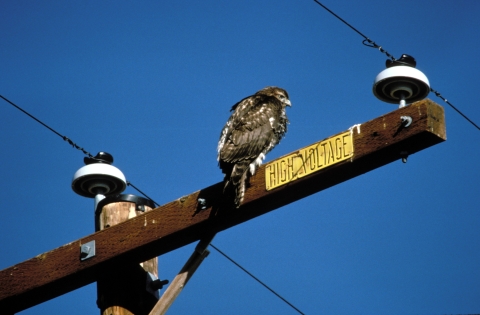In order to meet U.S. electricity demands, an estimated 7.1 million miles of above-ground distribution and transmission lines crisscross the country. Electricity delivery includes power generation at a power plant or a renewable energy source that is moved to transfer substations by transmission lines. Once at the substation, electricity is transferred to distribution lines that carry the power to the end user. As the need for electricity and power line infrastructure expands, so does the potential risk to birds.
How do power lines impact migratory birds?
Bird mortalities resulting from electric utility lines have been a long-standing bird conservation issue. Power line infrastructure kills millions of birds every year. Birds can be injured or killed from collisions with both distribution and transmission power lines in mid-flight. Distribution lines are a particular risk in locations frequently traveled by birds and in areas where poor weather or darkness could further decrease visibility.
Birds can be electrocuted when flying on or off a distribution pole or when a large number of birds roost on lines at the same time, causing them to sway and make connections. Distribution poles were historically designed with narrow clearances between energized components, which are often not insulated. Electrocutions occur at poles when a bird completes a circuit by simultaneously touching two energized parts (e.g., phase conductors) or an energized part and a grounded part.
Birds nesting on power line towers and poles have a greater risk of electrocutions and collisions, because nesting birds will have more flights close to power lines. Nesting material may also cause an electrical connection, or the nest material could catch on fire, killing the bird and damaging the power line structure structure
Something temporarily or permanently constructed, built, or placed; and constructed of natural or manufactured parts including, but not limited to, a building, shed, cabin, porch, bridge, walkway, stair steps, sign, landing, platform, dock, rack, fence, telecommunication device, antennae, fish cleaning table, satellite dish/mount, or well head.
Learn more about structure .
What can I do to avoid and minimize impacts to birds?
In the U.S., the issue of bird impacts from electric utility infrastructure, resulting from both collisions and electrocutions, gained national attention in the 1970s. Consequently, conservation agencies and electric utility companies formed the Avian Power Line Interaction Committee (APLIC) to understand the hazard and reduce the number of annual bird impacts. Solutions to this issue not only protect birds but also protect power supply reliability as electrocutions can cause power outages, damage equipment, and increase costs of operation and maintenance of the supply system.
There are proven solutions to bird electrocutions on distribution poles, whereas the science of power line collisions continues to have greater uncertainty. A number of options are currently recommended and available in APLIC’s guidance documents.
Design and siting are the most effective avoidance and minimization measures to reduce bird collisions. The Service recommends siting new transmission lines outside of areas considered high risk to birds and designing or retrofitting infrastructure to be “avian-safe” in these areas. Poles can be made avian-safe through design to minimize avian electrocution risk by providing sufficient separation between phases and between phases and grounds or by covering exposed parts with insulators to physically separate electricity from birds. We also recommend burying lines to minimize collision risk.
Library Documents
- APLIC Website
- Suggest Practices for Avian Protection on Power Lines: The State of the Art in 2006
- Reducing Avian Collision with Power Lines: The State of the Art in 2012
If you would like to provide comments on the information presented on this webpage, please contact the USFWS Migratory Bird Program at MigratoryBirds@fws.gov.




